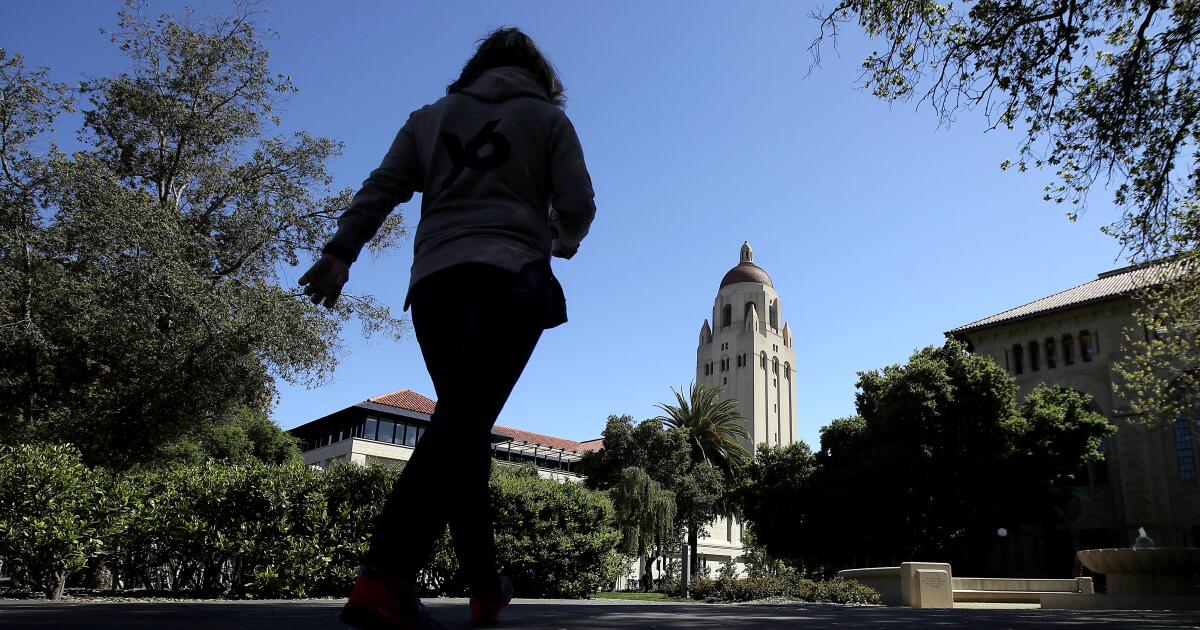Business
Column: Taxpayer 'protection' or taxpayer 'deception'? A new ballot measure aims to destroy the California state budget

It’s indisputable that the decline of state fiscal management in California began with the passage of Proposition 13 in 1978.
The tax-cutting initiative upended the tax structure that provided most of the revenues needed by localities and school districts, undermining the locals’ control of their own spending.
It was sold to voters as relief for beleaguered middle-class homeowners, but that was largely a scam: The chief beneficiaries have been the richest homeowners and commercial and industrial property owners, who have received billions of dollars in property tax breaks at the expense of residential owners.
These provisions discourage new government efforts no matter how urgent the problem to be addressed,…[and] hang like a shadow over budgets to be adopted in summer 2025.
— League of California Cities, et al
So it may be unsurprising that the heirs of Proposition 13’s proponents are trying to pull another fast one on California taxpayers.
Their tool, pushed chiefly by the California Business Roundtable, apartment developers and others of that ilk, is the so-called Taxpayer Protection and Government Accountability Act.
The Business Roundtable spent $6.375 million in 2022 pushing the initiative and an additional $770,000 last year; about $310,000 came in 2022 from the Howard Jarvis Taxpayers Assn., named after the chief promoter of Proposition 13, and about $400,000 last year from R.W. Selby & Co., a big apartment developer.
The initiative has been scheduled for the November ballot and will appear there unless the state Supreme Court throws it off; that’s what the measure’s critics have asked, citing numerous technical reasons.
The state’s political leadership is striking back in another way: through a public campaign targeting the Business Roundtable and its leading corporate members, and endorsed by Gov. Gavin Newsom, the Democratic legislative leaders, and organizations such as the League of California Cities, the Service Employees International Union, the California Medical Assn. and the California Teachers Assn.
Their strategem is to redefine the measure as the “Taxpayer Deception Act” and assert in public outreach that it would eliminate state funding for “paid family leave, disability insurance, gun violence prevention, and climate programs,” as well as funding for road and infrastructure maintenance.
Is this a fair assessment? It largely conforms to the judgment of the Legislative Analyst’s Office, which found that it would result in “lower annual state and local revenues, potentially substantially lower.”
As is so often the case when the business lobby starts whining about its difficulties operating in the largest economy and most vigorous consumer market in the United States, “deception” is an understatement.
But let’s start with the text of the initiative itself. Fundamentally, it would change the rule for the enactment of a tax increase from current law, which requires a two-thirds vote of each legislative chamber or passage by a majority of voters, to two-thirds of each chamber and a majority of voters. Obviously this raises the bar significantly.
The initiative also would redefine numerous governmental fees as taxes subject to the new rule. Perhaps most damaging, it would retroactively invalidate any revenue measures passed since Jan. 1, 2022, unless they’re re-ratified in 2025.
Taken together, “these provisions discourage new government efforts no matter how urgent the problem to be addressed, … hang like a shadow over budgets to be adopted in summer 2025, … and impair California governments’ ability to borrow,” a coalition of government advocacy organizations led by the League of California Cities told the Supreme Court in a friend-of-the-court letter. The prospect of passage is “already undermining certainty and impairing planning in government finance,” they wrote.
The initiative backers are plainly intent on riding generalized discontent with taxes to victory. The text bristles with shibboleths of the anti-tax movement, for example by blaming higher taxes on “unelected bureaucrats, empowered by politicians and the courts.” It ties itself to Proposition 13 by stating that its purpose is “to further protect the existing constitutional limit on property taxes” — i.e., Proposition 13.
Let’s take a closer look at the promoters’ lead slogans. One is that the initiative “stops politicians from using ‘hidden taxes’ disguised as fees to drive up the cost of government services.” This absurdly turns reality on its head. Taxes don’t “drive up” the cost of services — they’re levied to pay for government services, almost all of which are favored by taxpayers, and the disappearance of many of which would elicit a taxpayer revolt.
Another slogan holds that Californians are struggling with the “highest income tax, state sales tax, gas taxes, and poverty rate.”
It’s true that California’s top marginal income tax rate is the highest in the nation. But one can hardly blame that on “unelected bureaucrats”: Voters specifically endorsed the current top rates at the ballot box in 2004, 2012 and 2016 — the last by a 63%-37% vote.
The truth, moreover, is that the vast majority of California taxpayers don’t pay anywhere near the top rate, according to the Institute on Taxation and Economic Policy. Who does? The special interests behind this initiative. The highest marginal rates, ranging from 10.3% to 13.3%, kick in for single filers with incomes over $350,000 and couples with incomes of nearly $700,000 and higher.
California’s income tax is steeply progressive, meaning those who earn the most pay disproportionately more. The lowest-income 95% of households, with incomes of less than $25,200, pay less than about 4% of family income in state income tax; the highest 1%, with earnings of $862,000 or higher, pay nearly 9% of their earnings in income taxes.
If you’re wondering why executives sitting around the Business Roundtable might be agitating for lower taxes, there’s your answer.
It is true that the state sales tax rate of 7.5% is the highest in the nation. It’s also our most regressive tax, meaning it burdens lower-income Californians the most — costing the lowest-earning 20%, with household incomes of $25,200 or less, an average 7.6% of family income. That burden drops steadily as income rises, reaching a mere 1% for the blessed top 1% of earners.
One might reasonably ask why the income and sales tax rates are so high in California. The answer is Proposition 13, which eviscerated the property tax that was once the most stable and productive revenue source for local government. With the passage of Proposition 13, the revenue-raising responsibilities devolved to the state, which had no option for covering local needs except through the income and sales tax.
It should come as no surprise that the tax initiative backers don’t mention the property tax in their spiel. The reason is that California’s effective average property tax rate ranks only 33rd among the states; Texas and Florida, which boast of imposing no income tax, are both higher (6th and 26th, respectively, according to Census Bureau figures).
One other point bears mentioning, for perspective. It concerns who the beneficiaries are of these states’ tax structures. In Texas and Florida, it’s the rich. As a share of family income, the total tax burden in Texas falls heaviest on the lowest-income households — 12.8% of family income for those earning $21,700 or less — and lightest on the wealthiest — 4.6% of family income on the top 1%, earning $744,800 or more.
Florida looks the same: Households with earnings of $19,600 or less pay 13.2% of their income in state taxes, but the top 1%, earning $735,700 or more, fork over a mere 2.7% of their income in taxes.
California’s structure is much more equitable. All blocs in the income range, from the lowest 20% (less than $25,200) to the top 1% ($862,000 or more) shoulder burdens ranging from 10.3% to 12%.
Make no mistake: The promoters of the tax initiative want California to look more like Texas and Florida.
Gas taxes, which the initiative promoters also target, are a special case. It’s true that California’s gas tax is the highest in the country, at about 78 cents per gallon. But they also pay for benefits that most Californians would probably regret losing, including clean air, clean gas technology and road and bridge maintenance.
Also, a sizable contributor to the price Californians pay for gas is what Severin Borenstein of UC Berkeley has identified as the “mystery surcharge.” That’s a difference in gasoline prices, currently more than 40 cents per gallon extracted by oil producers, refiners or retailers at an unidentifiable point of the gasoline economy.
Borenstein originally traced the surcharge to a price spike following an explosion at Exxon Mobil’s Torrance refinery in 2015 that led to a more than year-long shutdown — but the spike never disappeared after the refinery came back online.
We can set aside the poverty rate for two reasons: First, its relationship to taxes is dubious, since households in poverty generally pay the lowest taxes (other than sales taxes) in California’s progressive system.
Second, according to the Census Bureau, California’s official poverty rate ranks 22nd among all states as measured by the percentage of residents living below the official poverty line, far better than states such as Mississippi, Alabama, Arkansas and West Virginia.
California does lead the nation in a calculation known as the supplemental poverty measure, but tax rates play almost no role in that calculation, which is based on factors such as housing costs.
Where does that leave us?
Proposition 13 was the child of legislative failure. Homeowners in the 1970s faced ever-higher property tax assessments due to a sharp run-up in home values. The Legislature could have crafted any of a myriad of solutions to deal with the crisis, but didn’t. The result was an outburst of voter fury at the ballot box in 1978, enacting the worst option of all.
Proposition 13 is what launched an era of government fees, for the simple if not obvious reason that the services and amenities California voters value have to be paid for somehow and Proposition 13 left few other options for doing so.
If California homeowners are struggling, one reason is that Proposition 13 shifted the burden of property taxes onto them: In 1975, single-family residences accounted for 39.9% of assessed values in Los Angeles County, and commercial-industrial properties for 46.6%. By 2018, the ratio had more than reversed, with houses accounting for 57.6% and commercial-industrial properties for 28.9%.
The “Taxpayer Protection Act” will make things worse. California voters will still want their services and amenities, but funding them will be much harder, so they’ll deteriorate. Voters will get angrier, but where will they turn and who will they blame?
The enduring rule of ballot measures applies here: If you want to know who will benefit from an initiative, just look who’s putting up the cash for it, and vote accordingly. The backers of the initiative say it’s “simple,” which is the clearest sign of all that it’s anything but.

Business
They graduated from Stanford. Due to AI, they can’t find a job

A Stanford software engineering degree used to be a golden ticket. Artificial intelligence has devalued it to bronze, recent graduates say.
The elite students are shocked by the lack of job offers as they finish studies at what is often ranked as the top university in America.
When they were freshmen, ChatGPT hadn’t yet been released upon the world. Today, AI can code better than most humans.
Top tech companies just don’t need as many fresh graduates.
“Stanford computer science graduates are struggling to find entry-level jobs” with the most prominent tech brands, said Jan Liphardt, associate professor of bioengineering at Stanford University. “I think that’s crazy.”
While the rapidly advancing coding capabilities of generative AI have made experienced engineers more productive, they have also hobbled the job prospects of early-career software engineers.
Stanford students describe a suddenly skewed job market, where just a small slice of graduates — those considered “cracked engineers” who already have thick resumes building products and doing research — are getting the few good jobs, leaving everyone else to fight for scraps.
“There’s definitely a very dreary mood on campus,” said a recent computer science graduate who asked not to be named so they could speak freely. “People [who are] job hunting are very stressed out, and it’s very hard for them to actually secure jobs.”
The shake-up is being felt across California colleges, including UC Berkeley, USC and others. The job search has been even tougher for those with less prestigious degrees.
Eylul Akgul graduated last year with a degree in computer science from Loyola Marymount University. She wasn’t getting offers, so she went home to Turkey and got some experience at a startup. In May, she returned to the U.S., and still, she was “ghosted” by hundreds of employers.
“The industry for programmers is getting very oversaturated,” Akgul said.
The engineers’ most significant competitor is getting stronger by the day. When ChatGPT launched in 2022, it could only code for 30 seconds at a time. Today’s AI agents can code for hours, and do basic programming faster with fewer mistakes.
Data suggests that even though AI startups like OpenAI and Anthropic are hiring many people, it is not offsetting the decline in hiring elsewhere. Employment for specific groups, such as early-career software developers between the ages of 22 and 25 has declined by nearly 20% from its peak in late 2022, according to a Stanford study.
It wasn’t just software engineers, but also customer service and accounting jobs that were highly exposed to competition from AI. The Stanford study estimated that entry-level hiring for AI-exposed jobs declined 13% relative to less-exposed jobs such as nursing.
In the Los Angeles region, another study estimated that close to 200,000 jobs are exposed. Around 40% of tasks done by call center workers, editors and personal finance experts could be automated and done by AI, according to an AI Exposure Index curated by resume builder MyPerfectResume.
Many tech startups and titans have not been shy about broadcasting that they are cutting back on hiring plans as AI allows them to do more programming with fewer people.
Anthropic Chief Executive Dario Amodei said that 70% to 90% of the code for some products at his company is written by his company’s AI, called Claude. In May, he predicted that AI’s capabilities will increase until close to 50% of all entry-level white-collar jobs might be wiped out in five years.
A common sentiment from hiring managers is that where they previously needed ten engineers, they now only need “two skilled engineers and one of these LLM-based agents,” which can be just as productive, said Nenad Medvidović, a computer science professor at the University of Southern California.
“We don’t need the junior developers anymore,” said Amr Awadallah, CEO of Vectara, a Palo Alto-based AI startup. “The AI now can code better than the average junior developer that comes out of the best schools out there.”
To be sure, AI is still a long way from causing the extinction of software engineers. As AI handles structured, repetitive tasks, human engineers’ jobs are shifting toward oversight.
Today’s AIs are powerful but “jagged,” meaning they can excel at certain math problems yet still fail basic logic tests and aren’t consistent. One study found that AI tools made experienced developers 19% slower at work, as they spent more time reviewing code and fixing errors.
Students should focus on learning how to manage and check the work of AI as well as getting experience working with it, said John David N. Dionisio, a computer science professor at LMU.
Stanford students say they are arriving at the job market and finding a split in the road; capable AI engineers can find jobs, but basic, old-school computer science jobs are disappearing.
As they hit this surprise speed bump, some students are lowering their standards and joining companies they wouldn’t have considered before. Some are creating their own startups. A large group of frustrated grads are deciding to continue their studies to beef up their resumes and add more skills needed to compete with AI.
“If you look at the enrollment numbers in the past two years, they’ve skyrocketed for people wanting to do a fifth-year master’s,” the Stanford graduate said. “It’s a whole other year, a whole other cycle to do recruiting. I would say, half of my friends are still on campus doing their fifth-year master’s.”
After four months of searching, LMU graduate Akgul finally landed a technical lead job at a software consultancy in Los Angeles. At her new job, she uses AI coding tools, but she feels like she has to do the work of three developers.
Universities and students will have to rethink their curricula and majors to ensure that their four years of study prepare them for a world with AI.
“That’s been a dramatic reversal from three years ago, when all of my undergraduate mentees found great jobs at the companies around us,” Stanford’s Liphardt said. “That has changed.”
Business
Disney+ to be part of a streaming bundle in Middle East

Walt Disney Co. is expanding its presence in the Middle East, inking a deal with Saudi media conglomerate MBC Group and UAE firm Anghami to form a streaming bundle.
The bundle will allow customers in Bahrain, Kuwait, Oman, Qatar, Saudi Arabia and the UAE to access a trio of streaming services — Disney+; MBC Group’s Shahid, which carries Arabic originals, live sports and events; and Anghami’s OSN+, which carries Arabic productions as well as Hollywood content.
The trio bundle costs AED89.99 per month, which is the price of two of the streaming services.
“This deal reflects a shared ambition between Disney+, Shahid and the MBC Group to shape the future of entertainment in the Middle East, a region that is seeing dynamic growth in the sector,” Karl Holmes, senior vice president and general manager of Disney+ EMEA, said in a statement.
Disney has already indicated it plans to grow in the Middle East.
Earlier this year, the company announced it would be building a new theme park in Abu Dhabi in partnership with local firm Miral, which would provide the capital, construction resources and operational oversight. Under the terms of the agreement, Disney would oversee the parks’ design, license its intellectual property and provide “operational expertise,” as well as collect a royalty.
Disney executives said at the time that the decision to build in the Middle East was a way to reach new audiences who were too far from the company’s current hubs in the U.S., Europe and Asia.
Business
Erewhon and others shut by fire set to reopen in Pacific Palisades mall

Fancy grocer Erewhon will return to Pacific Palisades in an entirely rebuilt store, as the neighborhood’s luxury mall, owned by developer Rick Caruso, undergoes renovations for a reopening next August.
Palisades Village has been closed since the Jan. 7 wildfire destroyed much of the neighborhood. The outdoor mall survived the blaze but needed to be refurbished to eliminate contaminants that the fire could have spread, Caruso said.
The developer is spending $60 million to bring back Palisades Village, removing and replacing drywall from stores and restaurants. Dirt from the outdoor areas is also being replaced.
Demolition is complete and the tenants’ spaces are now being restored, Caruso said.
“It was not a requirement to do that from a scientific standpoint,” he said. “But it was important to me to be able to tell guests that the property is safe and clean.”
Erewhon’s store was taken down to the studs and is being reconfigured with a larger outdoor seating area for dining and events.
When it opens its doors sometime next year, it will be the only grocer in the heart of the fire-ravaged neighborhood.
The announcement of Erewhon’s comeback marks a milestone in the recovery of Pacific Palisades and signals renewed investment in restoring essential neighborhood services and supporting the community’s long-term economic health, Caruso said.
A photograph of the exterior of Erewhon in Pacific Palisades in 2024.
(Kailyn Brown/Los Angeles Times)
“They are one of the sexiest supermarkets in the world now and they are in high demand,” he said. “Their committing to reopening is a big statement on the future of the Palisades and their belief that it’s going to be back stronger than ever.”
Caruso previously attributed the mall’s survival to the hard work of private firefighters and the fire-resistant materials used in the mall’s construction. The $200-million shopping and dining center opened in 2018 with a movie theater and a roster of upmarket tenants, including Erewhon.
“We’re honored to join the incredible effort underway at Palisades Village,” Erewhon Chief Executive Tony Antoci said in a statement. “Reopening is a meaningful way for us to contribute to the healing and renewal of this neighborhood.”
Erewhon has cultivated a following of shoppers who visit daily to grab a prepared meal or one of its celebrity-backed $20 smoothies.
The privately held company doesn’t share financial figures, but has said its all-day cafes occupy roughly 30% of its floor space and serve 100,000 customers each week.
Erewhon has also branched out beyond selling groceries.
Its fast-growing private-label line now includes Erewhon-branded apparel, bags, candles, nutritional supplements and bath and body products.
Erewhon will also open new stores in West Hollywood in February, in Glendale in May and at Caruso’s The Lakes at Thousand Oaks mall in July 2026.
About 90% of the tenants are expected to return to the mall when it reopens, Caruso said, including restaurants Angelini Ristorante & Bar and Hank’s. Local chef Nancy Silverton has agreed to move in with a new Italian steakhouse called Spacca Tutto.
In May, Pacific Palisades-based fashion designer Elyse Walker said she would reopen her eponymous store in Palisades Village after losing her 25-year flagship location on Antioch Street in the inferno.

Fashion designer Elyse Walker announced the reopening of her flagship store at the Palisades Village in May.
(Myung J. Chun/Los Angeles Times)
“People who live in the Palisades don’t want to leave,” Walker said at the time. “It’s a magical place.”
Caruso carried on annual holiday traditions at Palisades Village this year, including the lighting of a 50-foot Christmas tree for hundreds of celebrants Dec. 5. On Sunday evening, leaders from the Chabad Jewish Community Center of Pacific Palisades gathered at the mall to light a towering menorah.
A total of 6,822 structures were destroyed in the Palisades fire, including more than 5,500 residences and 100 commercial businesses, according to the California Department of Forestry and Fire Protection.
Caruso said he hopes the shopping center’s revival will inspire residents to return. His investment “shows my belief that the community is coming back,” he said. “Next year is going to be huge.”
-

 Iowa5 days ago
Iowa5 days agoAddy Brown motivated to step up in Audi Crooks’ absence vs. UNI
-

 Iowa6 days ago
Iowa6 days agoHow much snow did Iowa get? See Iowa’s latest snowfall totals
-

 Maine3 days ago
Maine3 days agoElementary-aged student killed in school bus crash in southern Maine
-

 Maryland5 days ago
Maryland5 days agoFrigid temperatures to start the week in Maryland
-

 Technology1 week ago
Technology1 week agoThe Game Awards are losing their luster
-

 South Dakota5 days ago
South Dakota5 days agoNature: Snow in South Dakota
-

 Nebraska1 week ago
Nebraska1 week agoNebraska lands commitment from DL Jayden Travers adding to early Top 5 recruiting class
-

 Sports1 week ago
Sports1 week agoPro Football Hall of Famer Troy Aikman critiques NIL landscape, transfer rules and Lane Kiffin’s LSU move


















